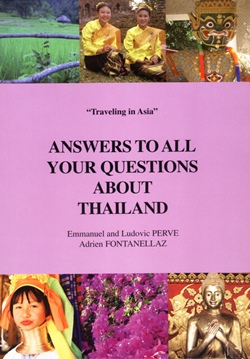Thailand is in many ways a wonderful country, but sometimes difficult to understand for the westerner. For these reasons, self-help groups such as ex-pat clubs are formed to try and answer the questions we all have from time to time.
Three authors (Emmanuel and Ludovic Perve and Adrien Fontanellaz) who gained their experience in Thailand while running guest houses, have put together this book Answers to all your Questions about Thailand (ISBN 974-93777-1-0), and although published in 2005, the questions and the answers are generally timeless.

It has been a small project of mine, to listen to the authoritarian bar-room lawyers and armchair experts pontificating at worst, advising at best, on all subjects Thai. Be that from whether a non-Thai can own a mobile phone, to even the very origins of the word “farang” used to describe us big-nosed, round-eyed foreigners. This book renders them redundant. Incidentally, question number 133 in this book gives a very interesting alternative answer to the usual “francais” origin which supposedly came after the French envoys to Ayutthya in the 16th century. There was a descriptive term for Europeans at the time of the crusades, termed “Frank” and linguistic studies can trace this word as the origin of the Arab “faranji”, the Persian “farang”, the Cambodian “balang” and the Vietnamese “pha-lang-xa”, as well as the Siamese “farang”.
The questions are divided into 11 broad sections, covering Practical Information, Nature, Food, Customs, Society, Buddhism, Arts and Traditions, History and Politics, Minority Ethnic Groups, Sports and Leisure Activities and finally, Language. In the center of the book there are also several color plates featuring a map of Thailand and photographic images of some native Thai items of interest.
The section on Minority Ethnic Groups I found particularly fascinating. For example, the reason why Hmong women do not divorce their husbands is that if they do so, they have to refund the bride price. If this were only the case in the western societies, I hear some of you saying!
There are some answers which will no doubt prompt further bar-room discussions; for example, the percentage of the Thai prostitution scene which is devoted to catering to foreigners (if you just said five percent, then you agree with the authors), and another on the origin of Kathoeys, and the fact that there was not just three genders in Thailand, but four! Turn to question 62 to get their answer.
The authors do not go into much detail of their own bona fides, and there is no bibliography at the end, though there are several pages of recommended reading, so one has to presume that their answers were culled from the reference books. Despite the leap of faith regarding the answers, I did find this to be a good reference tool, providing the reader with good information about Thailand. It is just a pity they did not include more information on themselves and their sources, and an index.
At B. 780, it is not cheap, but still reasonable value. Well worth looking out for at the local Bookazine, which supplied my copy.




